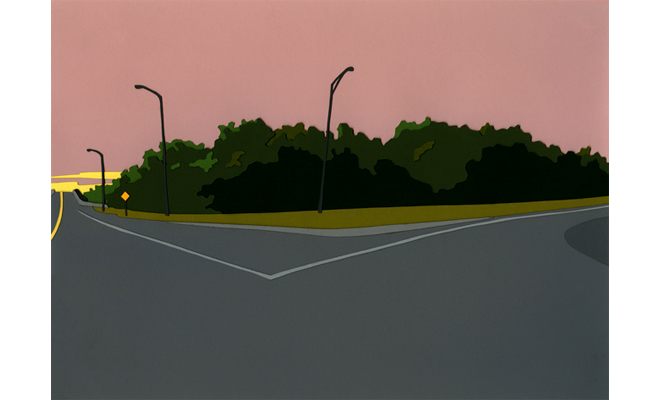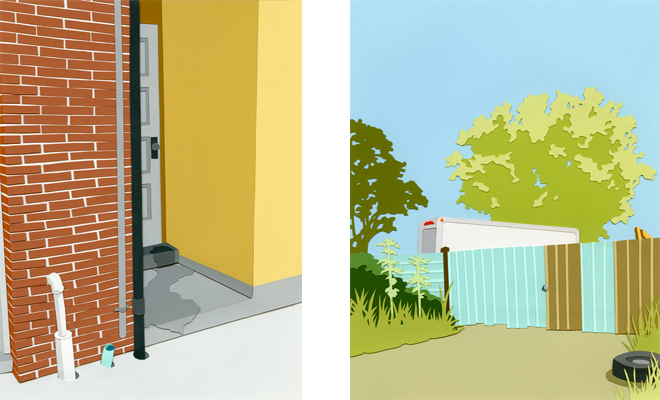Review: Casey Ruble at the Foundation Gallery

Casey Ruble, Michoud Boulevard, 2012. Cut paper collage. Courtesy the artist and the Foundation Gallery, New Orleans.
"The city, however, does not tell its past, but contains it like the lines of a hand, written in the corners of the streets, the gratings of the windows, the banisters of the steps, the antennae of the lightning rods, the poles of the flags, every segment marked in turn with scratches, indentations, scrolls." — Italo Calvino, from Invisible Cities
“Offing” is a nautical term referring to the part of the sea that can be seen from land closest to the horizon—a zone distant, but still imminent. Casey Ruble’s current exhibition suggests that the offing can be not only a physical distance, but also a temporal one. The passing of time, however indeterminate, leaves invisible marks on the places we live.
The New Jersey-based artist patches together small, beautiful landscapes of carefully cut pale-colored paper. Each work recalls a place of intense emotion, now left and forgotten—former orphanages, exhumed cemeteries, and locations of found murder victims in New Orleans. The tension of these sites is apparent in the surface of the collages. The immediate flatness of the even planes of color undermines the perspectival tricks used to depict depth. This push and pull of perception heightens the psychological anxiety of what might otherwise be banal scenes.
Ruble began the series for the forthcoming book, Unfathomable City: A New Orleans Atlas, a collection of maps and accompanying essays edited by Rebecca Solnit and Rebecca Snedeker. As with Ptolemy’s Geographia, these maps deal with chorography, "the qualities rather than the quantities of the things that it sets down." Ruble’s works depict the displacement of bodies both at the beginning and the end of life, framed so that there is an ominous suggestion of what else has or will happen.
The question remains: Are places forever marked by tragedy? While these sites may not advertise their history, there is perhaps an energy that still lingers. Ruble's works have a palpable sense that this city is a palimpsest for the lost populations that came before and will come after us.

Casey Ruble, North Rampart Street, 2012 (left) and Almonaster Boulevard, 2012 (right). Both cut paper collage. Courtesy the artist and the Foundation Gallery, New Orleans.
Editor's Note
Casey Ruble's "The Offing" on view until April 20, 2013 at the Foundation Gallery (608 Julia St) in New Orleans.
To read more on chorography and place memory, revisit Eva Díaz's 2011 Pelican Bomb essay on Deborah Luster's "Tooth for an Eye." Luster's work from this series is currently on view until April 7 at the Ogden Museum of Southern Art (925 Camp St) . Might the Pelican suggest a Ruble/Luster double header?



